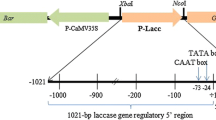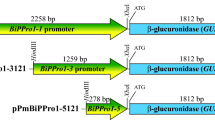Abstract
Phenylalanine ammonia-lyase (PAL) catalyzes the first step in phenylpropanoid metabolism and plays a central role in the biosynthesis of phenylpropanoid compounds. We have previously cloned two PAL genes, PAL1 and PAL2, from a Populus trichocarpa × P. deltoides F1 hybrid. Here, we describe the properties of PAL1 and PAL2 promoters and their expression patterns in transgenic tobacco and poplar. The promoters were 75% identical in the regions sequenced, and each contained two copies of AC-rich putative cis-acting elements that matched a consensus plant myb transcription factor binding site sequence. In transgenic tobacco, PAL1-GUS and PAL2-GUS fusions directed similar patterns of expression in developing primary xylem of leaves, stems, and other organs, and in secondary xylem of stems. Contrary to previously documented patterns of PAL1/2 expression in poplar, no expression of either fusion was detected in epidermal or subepidermal cell layers of young tobacco leaves or stems. In poplar, the PAL2-GUS fusion directed the highest levels of expression in roots and young leaves and stems. In young leaves and stems, high GUS activity was detected in epidermal or subepidermal cells as well as in primary xylem and phloem fibers. GUS activity was low in woody stems, and was weak or absent in developing secondary xylem. The patterns of PAL2-GUS expression in poplar are very similar to those of PAL1/2 mRNA accumulation in poplar. However, the distinct patterns of expression directed by the PAL2 promoter in poplar and tobacco show that PAL2-GUS expression in tobacco does not accurately reflect all aspects of PAL2 expression in poplar.
Similar content being viewed by others
References
Allina SM, Pri-Hadash A, Theilmann DA, Ellis BE, and Douglas CJ: 4-coumarate:enzyme A ligase in hybrid poplar. Properties of native enzymes, cDNA cloning, and analysis of recombinant enzymes. Plant Physiol 116: 743–754(1998).
Bate NJ, Orr J, Ni W, Meromi A, Nadler-Hassar T, Doerner PW, Dixon RA, Lamb CJ, Elkind Y: Quantitative relationship between phenylalanine ammonia-lyase levels and phenylpropanoid accumulation in transgenic tobacco identi-fies a rate-determining step in natural product synthesis. Proc Natl Acad Sci USA 9108: 7608–7612(1994).
Bell-Lelong DA, Cusumano JC, Meyer K, Chapple C: Cinnamate-4-hydroxylase expression in Arabidopsis: regulation in response to development and the environment. Plant Physiol 113: 729–738(1997).
Bevan M: Binary Agrobacterium vectors for plant transformation. Nucl Acids Res 12: 8711–8721(1984).
Bevan M, Shufflebottom D, Edwards K, Jefferson R, Schuch W: Tissue-and cell-specific activity of a phenylalanine ammonia-lyase promoter in transgenic plants. EMBO J 8: 1899–1906(1989).
Chappell J, Hahlbrock K: Transcription of plant defence genes in response to light and elicitor. Nature 311: 76–78(1984).
Dixon RA, Paiva NL: Stress-induced phenylpropanoid metabolism. Plant Cell 7: 1085–1097(1995).
Douglas CJ, Hoffmann H, Schulz W, Hahlbrock K: Structure and elicitor or u.v.-light-stimulated expression of two 4-coumarate:CoA ligase genes in parsley. EMBO J 6: 1189–1195 (1987).
Douglas, CJ: Phenylpropanoid metabolism and lignin biosynthesis: from weeds to trees. Trends Plant Sci 1: 171–178 (1996).
English S, Greenaway W, Whatley FR: Analysis of phenolics of Populus trichocarpa by GC-MS. Phytochemistry 30: 531–533 (1991).
Feldbruegge M, Sprenger M, Hahlbrock K, Weisshaar B: Pcmyb1, a novel plant protein containing a DNA-binding domain with one Myb repeat, interacts in vivo with a lightregulatory promoter unit. Plant J 11: 1079–1093(1997).
Feuillet C, Lauvergeat V, Deswarte C, Pilate G, Boudet A, Grima-Pettenati J: Tissue-and cell-specific expression of a cinnamyl alcohol dehydrogenase promoter in transgenic poplar plants. Plant Mol Biol 27: 651–667(1995).
Grotewold E, Drummond B, Bowen B, Peterson T: The mybhomologous P gene controls phlobene pigmentation in maize floral organs by directly activating a flavonoid biosynthetic gene subunit. Cell 76: 543–553(1994).
Hatton D, Sablowski R, Yung MH, Smith C, SchuchW, Bevan M: Two classes of cis sequences contribute to tissue-specific expression of a PAL2 promoter in transgenic tobacco. Plant J 7: 859–876 (1995).
Hatton D, Smith C, Bevan M: Tissue-specific expression of the PAL3 promoter requires the interaction of two conserved cis sequences. Plant Mol Biol 31: 393–397(1996).
Hauffe KD, Paszkowski U, Schulze-Lefert P, Hahlbrock K, Dangl L, Douglas CJ: A parsley 4CL-1 promoter fragment specifies complex expression patterns in transgenic tobacco. Plant Cell 3: 435–443(1991).
Hawkins S, Samaj J, Lauvergeat V, Boudet A, Grima-Pettenati J: Cinnamyl alcohol dehydrogenase: identification of new sites of promoter activity in transgenic poplar. Plant Physiol 113: 321–325(1997).
Hegnauer R: Chemotaxonomie der Pflanzen, vol 6, pp. 241–259. Birkhäuaser-Verlag (1973).
Howles PA, Sewalt VJH, Paiva NL, Elkind Y, Bate NJ, Lamb C., Dixon RA: Over-expression of L-phenylalanine ammonialyase in transgenic tobacco plants reveals control points for flux into phenylpropanoid biosynthesis. Plant Physiol 112: 1617–1624(1996).
Jefferson RA: Assaying chimeric genes in plants: The GUS gene fusion system. Plant Mol Biol Rep 5: 387–405(1987).
Kawamata S, Shimoharai K, Imura Y Ozaki M Ichinose Y, Shiraishi T, Kunoh H, Yamada T: Temporal and spatial pattern of expression of the pea phenylalanine ammonia-lyase gene1 promoter in transgenic tobacco. Plant Cell Physiol 38: 792–803 (1997).
Lawton M, Lamb C: Transcriptional activation of plant defense genes by fungal elicitor, wounding and infection. Mol Cell Biol 7: 335–341(1987).
Leple J, Brasileiro A, Michel M, Delmotte F, JoLianin L: Transgenic poplars: expression of chimeric genes using different constructs. Plant Cell Rep 11: 137–141(1992).
Leyva A, Liang X, Pintor-Toro JA, Dixon RA, Lamb, C J: cis-element combinations determine phenylalanine ammonialyase gene tissue-specific expression patterns. Plant Cell 4: 26–271(1992).
Liang XW, Dron M, Cramer CL, Dixon RA, Lamb CJ: Differential regulation of phenylalanine ammonia-lyase genes during plant development and by environmental cues. J Biol Chem 264: 14486–1442(1989).
Liang XW, Dron M, Schmid J, Dixon RA, Lamb CJ: Developmental and environmental regulation of a phenylalanine ammonia-lyase-beta-glucuronidase gene fusion in transgenic tobacco plants. Proc Natl Acad Sci USA 86: 9284–9288 (1989).
Logemann E, Parniske M, Hahlbrock K: Modes of expression and common structural features of the complete phenylalanine ammonia-lyase gene family in parsley. Proc Natl Acad Sci USA 92: 5905–5909(1995).
Lois R, Dietrich A, Hahlbrock K, Schulz W: A phenylalanine ammonia-lyase gene from parsley: structure, regulation and identification of elicitor and light responsive cis-acting elements. EMBO J 8: 1641–1648(1989).
Lois R, Hahlbrock K: Differential wound activation of members of the phenylalanine ammonia-lyase and 4-coumarate:CoA ligase gene families in various organs of parsley plants. Z Naturforsch C 47: 90–94(1992).
Mauch-Mani B, Slusarenko A: Production of salicylic acid precursors is a major function of phenylalanine ammonialyase in the resistance of Arabidopsis to Peronospora parasitica. Plant Cell 8: 203–212( 1996).
Mckegney G, Butland S, Theilmann D, Ellis B: Expression of poplar phenylalanine ammonia-lyase in insect cell cultures. Phytochemistry 41: 1259–1263(1996).
Moniz de Sá M, Subramaniam R, Williams FE, Douglas CJ: Rapid activation of phenylpropanoid metabolism in elicitor treated hybrid poplar (Populus trichocarpa Torr and Gray _Populus deltoides Marsh) suspension-cultured cells. Plant Physiol 98: 728–737(1992).
Nilsson O, Little CHA, Sandberg G, Olsson O: Expression of two heterologous promoters. Agrobacterium rhizogenes RolC and cauliflower mosaic virus 35S, in the stem of transgenic hybrid aspen plants during the annual cycle of growth and dormancy. Plant Mol Biol 31: 887–895(1996).
Ohl S, Hedrick SA, Chory J, Lamb CJ: Functional properties of a phenylalanine ammonia-lyase promoter from Arabidopsis. Plant Cell 2: 837–848(1990).
Osakabe Y, Osakabe K, Kawai S, Katayama Y, Morohoshi, N: Characterization of the structure and determination of mRNA levels of the phenylalanine ammonia-lyase gene family from Populus kitakamiensis. Plant Mol Biol 28:1133–1141(1995).
Osakabe Y, Osakabe K, Kawai S., Katayama Y, Morohoshi N: Structure and tissue-specific expression of genes for phenylalanine ammonia-lyase from a hybrid aspen. Plant Sci 105: 217–226(1995).
Pearl IA, Darling SF: Phenolic extractives of leaves of Populus balsamifera and of P. trichocarpa. Phytochemistry 10: 2844–2847 (1971)
Reinold S, Hahlbrock K: Biphasic temporal and spatial induction patterns of defense-related mRNAs and proteins in fungus-infected parsley leaves. Plant Physiol 112: 131 (1996).
Sablowski RWM, Baulcombe DC, Bevan M: Expression of a flower-specific Myb protein in leaf cells using a viral vector causes ectopic activation of a target promoter. Proc Natl Acad Sci USA 92: 6901–6905(1995).
Sablowski RW, Moyano E, Culianez-Macia FA, Schuch W Martin C, Bevan M: A flower-specific Myb protein activates transcription of phenylpropanoid biosynthetic genes. EMBO J 13: 128–137(1994).
Schulze-Lefert P, Dangl JL, Becker-Andre A, Hahlbrock K, Schulz W: Inducible in vivo footprints define sequences necessary for UV-light activation of the parsley chalcone synthase gene. EMBO J 8: 651–656(1989).
Subramaniam R, Reinold S, Molitor EK, Douglas, CJ: Structure, inheritance, and expression of hybrid poplar (Populus trichocarpa _Populus deltoides) phenylalanine ammonia-lyase genes. Plant Physiol 102: 71–83(1993).
Shufflebottom D, Edwards K, Schuch W, Bevan M: Transcription of two members of a gene family encoding phenylalanine ammonia-lyase leads to remarkably different cell specificities and induction patterns. Plant J 3: 835–845(1993).
Wanner LA, Li G, Ware D, Somssich IE, Davis KR: The phenylalanine ammonia-lyase gene family in Arabidopsis thaliana. Plant Mol Biol 27: 327–338(1995).
Whetten R, Sederoff R: Lignin biosynthesis. Plant Cell 7: 1001–1013(1995).
Wu SC, Hahlbrock K: In situ localization of phenylpropanoidrelated gene expression in different tissues of light-grown and dark-grown parsley seedlings. Z Naturforsch C 47: 591–600 (1992).
Author information
Authors and Affiliations
Rights and permissions
About this article
Cite this article
Gray-Mitsumune, M., Molitor, E.K., Cukovic, D. et al. Developmentally regulated patterns of expression directed by poplar PAL promoters in transgenic tobacco and poplar. Plant Mol Biol 39, 657–669 (1999). https://doi.org/10.1023/A:1006148715050
Issue Date:
DOI: https://doi.org/10.1023/A:1006148715050




